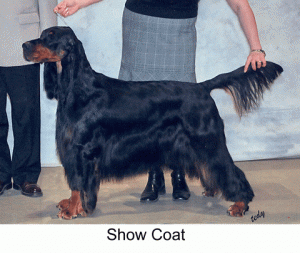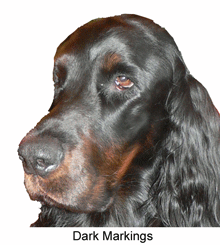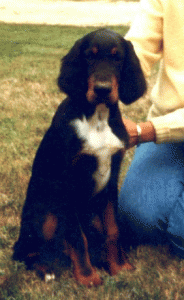Interpretation | Coat & Markings | Head | Neck & Forequarters | Body | Hindquarters & Tail | Gait
Coat Discussion
Coat and Markings are dealt with fairly carefully but since this standard was written in 1963 both factors have taken on added importance and deserve attention.
 The coat is correctly described as soft and shining, straight or slightly waved, but not curly, with long hair on ears, under stomach and on chest, on back of the front and hind legs, and on tail. Limitations are only implied as to the amount of coat, since at the time, the Gordon was not an especially long coated dog. Dense coat, yes, but heavy feathering, rarely. The use of the dog for hunting also implies restrictions to enable him to appear “capable of doing a full day’s work in the field.”
The coat is correctly described as soft and shining, straight or slightly waved, but not curly, with long hair on ears, under stomach and on chest, on back of the front and hind legs, and on tail. Limitations are only implied as to the amount of coat, since at the time, the Gordon was not an especially long coated dog. Dense coat, yes, but heavy feathering, rarely. The use of the dog for hunting also implies restrictions to enable him to appear “capable of doing a full day’s work in the field.”
The rapidly growing popularity of the Gordons as a show dog has encouraged the breeding for coat, and now he is often seen with a [greater] amount of feathering.
CKC Standard States:
 Coat should be soft and shining, resembling silk, straight or slightly waved – the latter preferred – but not curly, with long hair on ears, under stomach, on chest and on back of the fore and hind legs to feet.
Coat should be soft and shining, resembling silk, straight or slightly waved – the latter preferred – but not curly, with long hair on ears, under stomach, on chest and on back of the fore and hind legs to feet.
Deep shining coal-black with tan markings either of rich chestnut or mahogany red colour. The tan should be shining and not dull, yellowish or straw colour and not mixed with black hairs. Black penciling allowed on toes. The borderlines between black and tan colours should be clearly defined. There should not be any tan colours mixed in the black.
Faults
Coat – Curly like wool, not shining.
Colour – Yellow or straw coloured tan or without clearly defined lines between the different colours. White feet. Too much white on the chest. In the black there must be no tan hairs which can often appear around the eyes.
AKC Standard Adds:
Coat: …with long hair on the tail.
——————
Confusion exists over the markings. The standard describes the uppermost limit of the amount of tan desired but this is not stated. Therefore it is too often assumed that less amount of tan is negative. Regrettably the breed carries a recessive factor for solid red puppies, and breeding only from correctly marked dogs or more surely from those with an excessive amount of tan, the possibility of getting red puppies is ever present. The Gordon with lesser amounts of tan does have a place in a breeding program, as it can help control this problem.
White markings are another matter which deserves comment. First, it must be remembered that the early Gordons were often tricolored, and the white gene cannot ever be completely eliminated. Spots of white often appear on the chest of pups and more often than not they diminish to a few white hairs. Pups may be born with white toenails and white hairs on the toes but these grow out as well. Same for the white hair found in the tail and the long hair on the back of the thighs; it grows out. There is no known reason for this phenomenon. Color changes on the pups, as well. Those born with brilliant tan markings often turn darker and more moderate, while the pups with little tan will surely develop more. When a Gordon reaches the age of eight or nine years his tan will often diminish both on the muzzle and on the feet.
CKC Standard States:
- Two clear spots over the eyes, not over 3/4 inch (2cm) in diameter.
- On the sides of the muzzle, the tan should not reach above the base of the nose, resembling a stripe around the end of the muzzle from one side to the other.
- On the throat.
- Two large clear spots on the chest.
- On the inside of hind legs and inside of thighs showing down the front of the stifle and broadening out to the outside of the hind legs from hock to toe. It must however, not completely eliminate the black on the back of the hind legs.
- On the forelegs from knees or a little above downwards to the toes.
- Around the vent.
- A white spot on the chest is allowed, but the smaller the better.
Faults
Colour – Yellow or straw coloured tan or without clearly defined lines between the different colours. White feet. Too much white on the chest. In the black there must be no tan hairs which can often appear around the eyes.
AKC Standard adds:
The tan should not reach to the top of the muzzle
Predominantly tan, red or buff dogs which do not have the typical pattern of markings of a Gordon Setter are ineligible for showing and undesirable for breeding.
——————
Discussions taken with permission from The Complete Gordon Setter by Anita Lustenberger & Jean Sanger Look, Howell Publishing, 1984-1989.



